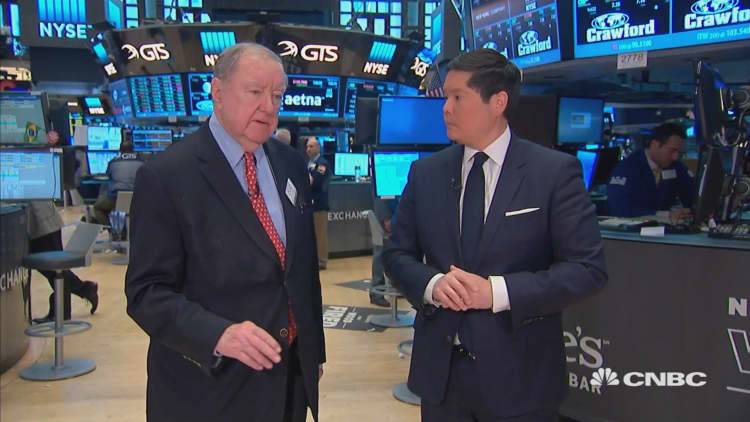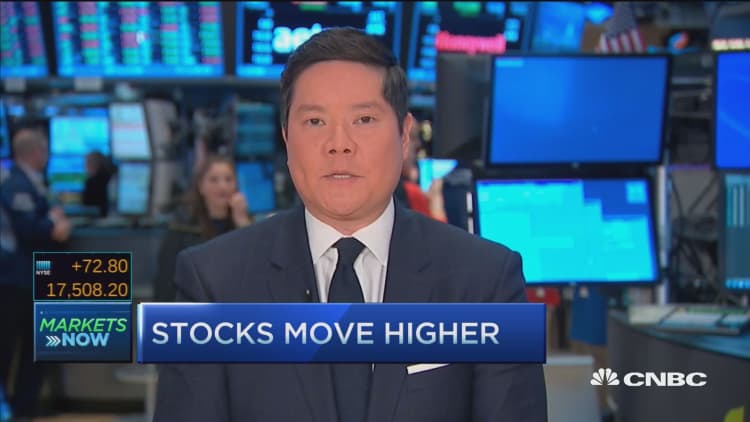


U.S. stocks closed higher Friday, with tech stocks leading. The Dow Jones industrial average failed to recover gains for the week after stocks fell amid renewed concerns of a rate hike sooner rather than later.
The Dow closed about 65 points higher, with IBM and Travelers contributing the most to gains. Information technology rose nearly 1.2 percent to lead nearly all S&P 500 sectors higher. The Nasdaq composite outperformed with gains of 1.2 percent, helped by gains in shares of Apple, Comcast and Applied Materials.
"It looks like the market is just kind of doing the rebound from all the Fed talk this week," said Chuck Self, CIO of iSectors. He noted some support for stocks from stabilization in oil prices.
Energy was the best S&P 500 performer on the week, with the broad index snapping a three-week losing streak. The Dow fell 0.2 percent for the week, for its first four-week losing streak since the one ended October 2014. (Tweet This) McDonald's, Boeing and 3M had the greatest negative impact on the index for the week.
U.S. crude oil futures for June delivery settled down 41 cents, or 0.85 percent, at $47.75 a barrel, up more than 3 percent for the week. The contract rolled to July after the settle. Meanwhile, Baker Hughes' weekly rig count remained unchanged.
The Dow transports closed up 1.1 percent, with Avis Budget leading nearly all constituents higher.
"It is (options) expiration today. I can't tell you what's noise related to flows around expiration," said Peter Boockvar, chief market analyst at The Lindsey Group. He noted that weakness in the euro and the yen supported a rise in those regional indexes overnight, helping U.S. stocks rise amid "a dearth of news here."
Read More Signs of fear are running rampant through the market
In the only major economic release of the day, existing home sales increased 1.7 percent in April to an annual rate of 5.45 million units, according to the National Association of Realtors. March's sales pace was revised slightly higher to 5.36 million units from the previously reported 5.33 million units, Reuters said.
"That was another positive," said Thomas Wilson, senior investment manager and managing director of wealth advisory at Brinker Capital.
Treasury yields turned lower, with the around 0.86 percent and the 10-year yield near 1.85 percent.
The U.S. dollar index was a touch higher for its fourth-straight day of gains and its first three-week win streak since March 2015. The euro was near $1.122 and the yen near 110.1 yen against the greenback.
European stocks closed more than 1 percent higher, with bank stocks outperforming. The STOXX Europe 600 Banks index gained 3.1 percent for the week, its second-straight week of gains. The German DAX lost nearly 0.4 percent for the week.
Asian stocks closed higher on the day, but the Shanghai composite ended the week a touch lower for its first five-week losing streak since 2012. The Hang Seng snapped a three-week losing streak with gains of 0.67 percent for the week.
The Nikkei 225 gained nearly 2 percent for the week, its second-straight week of gains, as the G-7 finance leaders' meeting kicked off in Japan Friday.
Read MoreThe Fed brought this fear back to markets this week
In earnings news, Campbell Soup reported quarterly earnings a share above estimates on revenue that was a touch lower. The soup and food maker noted continuation of a "very challenging consumer environment," but it did raise its full-year earnings forecast. Shares fell nearly 6.4 percent.
Deere posted earnings that beat on both the top and bottom line. The heavy equipment maker noted the continuing downturn in the global farm economy, as well as weakness in the construction equipment sector, but said it was helped by its flexible cost structure, among other factors. The stock closed nearly 5.5 percent lower.
Foot Locker matched estimates with first-quarter profit of $1.39 per share. Revenue was slightly below analysts' expectations, and the comparable-store sales increase of 2.9 percent was below consensus estimates of a 4.5 percent jump. The company notes that profits were at a record level, and that the company did well in dealing with rapidly shifting customer tastes. Shares closed almost 6.5 percent lower.
As of the close Thursday, the major averages were tracking for a weekly decline. The Dow and S&P were on pace for their first four-week losing streak since the one ended October 2014, while the Nasdaq composite was on pace for its first five-week losing streak since 2012.
U.S. stocks closed lower Thursday after comments from New York Fed President William Dudley and the latest Fed minutes increased prospects of a rate hike as soon as June.
Read More Early movers: DE, CPB, FL, HIBB, BKE, TWTR, GPS, ROST & more
The Dow Jones industrial average closed up 65.54 points, or 0.38 percent, at 17,500.94, with DuPont leading advancers and McDonald's the greatest decliner.
The Dow fell 0.2 percent for the week and is up 0.44 percent for the year so far.
The closed up 12.28 points, or 0.60 percent, at 2,052.32, with information technology leading nine sectors higher and consumer staples the only decliner.
The index gained 0.28 percent for the week and is up 0.41 percent for the year so far.
The Nasdaq composite closed up 57.03 points, or 1.21 percent, at 4,769.56.
The Nasdaq rose 1.1 percent for the week and is down 4.75 percent for the year so far.
The CBOE Volatility Index (VIX), widely considered the best gauge of fear in the market, fell to trade near 15.2.
About four stocks advanced for every decliner on the New York Stock Exchange, with an exchange volume of 962 million and a composite volume of nearly 3.5 billion in the close.
High-frequency trading accounted for 49 percent of May's daily trading volume of about 7.23 billion shares, according to TABB Group. During the peak levels of high-frequency trading in 2009, about 61 percent of 9.8 billion of average daily shares traded were executed by high-frequency traders.
Gold futures for June delivery settled down $1.90 at $1,252.90 an ounce, its lowest since April 27 and posting a second-straight week of decline.
—CNBC's Peter Schacknow contributed to this report.




